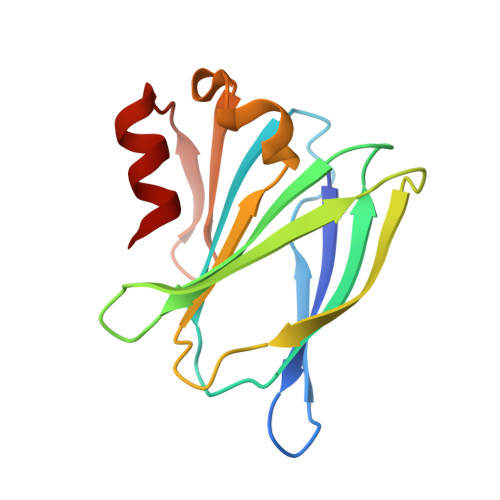Novel histone H3 binding protein ORF158L from the Singapore grouper iridovirus
Tran, B.N., Chen, L., Liu, Y., Wu, J., Velazquez-Campoy, A., Sivaraman, J., Hew, C.L.(2011) J Virol 85: 9159-9166
- PubMed: 21715494
- DOI: https://doi.org/10.1128/JVI.02219-10
- Primary Citation of Related Structures:
3RJ2 - PubMed Abstract:
Singapore grouper iridovirus (SGIV), a major pathogen of concern for grouper aquaculture, has a double-stranded DNA (dsDNA) genome with 162 predicted open reading frames, for which a total of 62 SGIV proteins have been identified. One of these, ORF158L, bears no sequence homology to any other known protein. Knockdown of orf158L using antisense morpholino oligonucleotides resulted in a significant decrease in virus yield in grouper embryonic cells. ORF158L was observed in nuclei and virus assembly centers of virus-infected cells. This observation led us to study the structure and function of ORF158L. The crystal structure determined at 2.2-Å resolution reveals that ORF158L partially exhibits a structural resemblance to the histone binding region of antisilencing factor 1 (Asf1), a histone H3/H4 chaperon, despite the fact that there is no significant sequence identity between the two proteins. Interactions of ORF158L with the histone H3/H4 complex and H3 were demonstrated by isothermal titration calorimetry (ITC) experiments. Subsequently, the results of ITC studies on structure-based mutants of ORF158L suggested Arg67 and Ala93 were key residues for histone H3 interactions. Moreover, a combination of approaches of ORF158L knockdown and isobaric tags/mass spectrometry for relative and absolute quantifications (iTRAQ) revealed that ORF158L may be involved in both the regulation and the expression of histone H3 and H3 methylation. Our present studies suggest that ORF158L may function as a histone H3 chaperon, enabling it to control host cellular gene expression and to facilitate viral replication.
Organizational Affiliation:
Department of Biological Sciences, National University of Singapore, 14 Science Drive 4, Singapore 117543, Singapore.














